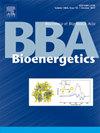Photodamage and excitation energy quenching in PSII: A time-resolved fluorescence study in Arabidopsis
IF 2.7
2区 生物学
Q2 BIOCHEMISTRY & MOLECULAR BIOLOGY
引用次数: 0
Abstract
Photosynthesis is driven by light absorbed in photosystem (PS) I and II. Paradoxically, light can also inactivate photosynthesis, mainly by damage to PSII. The light-dependent decrease in functional PSII, referred to as photoinhibition, is initially accompanied by an increase of excitation quenching, energy dissipation characterized by a decline in the lifetime and yield of chlorophyll fluorescence. In plants, research has not yet been performed on the effect of photoinhibition on the fluorescence lifetime of PSII in conditions where the PSII reaction centers are closed or remain open (capable of performing photochemistry).
In this work, we studied the effect of photoinhibition on the fluorescence lifetime of PSII in Arabidopsis thaliana using time-resolved fluorescence measurements with a streak-camera setup in both closing (Fm) and non-closing (Fo) conditions. Measurements under Fm conditions in the chlorina mutant, lacking peripheral antenna, demonstrate formation of a photoinhibitory quencher in the PSII core complex. In Fo, the average fluorescence lifetime of PSII increases upon induction of photoinhibition. This could be due to the degradation of quenched PSII core reaction center protein by FtsH proteases, which leads to unquenched and dysfunctional PSII. We tested this hypothesis by comparing WT plants with the FtsH2 lacking mutant. Based on the similar behavior, we conclude that degradation by FtsH proteases is not the main cause of the increase. Instead this increase is caused by the larger antenna size of still functional PSII. These findings provide new insights into the impact of photoinhibition on the PSII fluorescence lifetime in A. thaliana.
拟南芥PSII的光损伤和激发能猝灭:一个时间分辨荧光研究。
光合作用是由光系统I和II吸收的光驱动的。矛盾的是,光也可以使光合作用失活,主要是通过损害PSII。功能性PSII的光依赖性下降,称为光抑制,最初伴随着激发猝灭和能量耗散的增加,其特征是叶绿素荧光的寿命和产量下降。在植物中,在PSII反应中心关闭或保持开放(能够进行光化学反应)的条件下,光抑制对PSII荧光寿命的影响尚未进行研究。在这项工作中,我们研究了光抑制对拟南芥PSII荧光寿命的影响,利用条纹相机装置在关闭(Fm)和非关闭(Fo)条件下进行了时间分辨荧光测量。在Fm条件下对缺乏外围天线的氯突变体的测量表明,在PSII核心复合物中形成了光抑制猝灭剂。在Fo中,PSII的平均荧光寿命随着光抑制的诱导而增加。这可能是由于被淬灭的PSII核心反应中心蛋白被FtsH蛋白酶降解,从而导致未淬灭和功能失调的PSII。我们通过比较WT植株和缺乏FtsH2的突变体来验证这一假设。基于类似的行为,我们得出结论,FtsH蛋白酶的降解不是增加的主要原因。相反,这种增加是由仍然有效的PSII的较大天线尺寸引起的。这些发现为研究光抑制对拟南芥PSII荧光寿命的影响提供了新的见解。
本文章由计算机程序翻译,如有差异,请以英文原文为准。
求助全文
约1分钟内获得全文
求助全文
来源期刊

Biochimica et Biophysica Acta-Bioenergetics
生物-生化与分子生物学
CiteScore
9.50
自引率
7.00%
发文量
363
审稿时长
92 days
期刊介绍:
BBA Bioenergetics covers the area of biological membranes involved in energy transfer and conversion. In particular, it focuses on the structures obtained by X-ray crystallography and other approaches, and molecular mechanisms of the components of photosynthesis, mitochondrial and bacterial respiration, oxidative phosphorylation, motility and transport. It spans applications of structural biology, molecular modeling, spectroscopy and biophysics in these systems, through bioenergetic aspects of mitochondrial biology including biomedicine aspects of energy metabolism in mitochondrial disorders, neurodegenerative diseases like Parkinson''s and Alzheimer''s, aging, diabetes and even cancer.
 求助内容:
求助内容: 应助结果提醒方式:
应助结果提醒方式:


